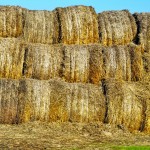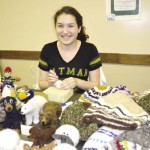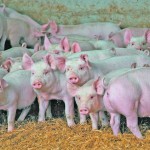Run the numbers before deciding on how to store hay Covering good hay can pay, study shows There are many alternatives for protecting a hay harvest, from full-on storage sheds with walls and doors to tarps and dangling weights. Leaving round bales outside in rows side by side or “mushroom style” results in spoilage losses

Run the numbers before deciding on how to store hay

White spots speak volumes about alfalfa’s needs
Alfalfa can pull down its own nitrogen from the atmosphere, but can’t conjure up phosphorus, potassium, sulphur, and boron out of thin air
Alfalfa isn’t a plant that complains a lot, but white spots on its leaves are a clear plea for more potash. After poking around in the field surrounded by whispering poplars at the recent Hay Day tour near Neepawa, provincial soil fertility specialist John Heard pointed out a shining example of “full-blown potassium deficiency.” Farmers
Blue Hills Fibre Fest brings shepherds, spinners and knitters together
Manitoba has both sheep and knitters, but somehow over the years, the thread that once connected them has been lost. In a bid to tie those two loose ends together, the Manitoba Sheep Association recently put on the Blue Hills Fibre Fest, the first of what is hoped will be an annual event showcasing locally
CFIA hands over anthrax control to provincial authorities
Manitoba’s Office of the Chief Veterinarian is moving in as the Canadian Food Inspection Agency pulls out of the anthrax business. The agency announced last fall it would be handing over responsibility to provincial authorities, saying the endemic presence of anthrax in some areas means eradication is not feasible. It wants its staff to focus
Rhizobia just the tip of the iceberg, researchers say
A new field of research looks at dark septate endophytes’ potential for helping crops become more efficient and cope with stress
Everybody and their pea-growing grandma knows about rhizobia, the nitrogen-fixing soil bacteria. But there are a host of other beneficial soil organisms that could potentially boost crop growth, increase stress tolerance, and reduce the need for fertilizer, say scientists at Agriculture and Agri-Food Canada’s Semi-Arid Prairie Agricultural Research Centre in Swift Current. Dark septate endophytes,
Deadly new hog disease has officials on high alert
Deadly new hog disease has officials on high alert Keeping an emerging and devastating swine disease out of Manitoba will require a team effort, says the Manitoba Pork Council’s point man on the issue. That means truckers, gathering yards, and farmers need to work together to keep Porcine Epidemic Diarrhea (PED) out of the province,

A new market opens up for Manitoba forage-finished cattle
A Minnesota-based entrepreneur who has landed a contract supplying grass-finished beef to the retail giant Target says he wants to source at least some of it from Manitoba. Todd Churchill, the entrepreneur behind Thousand Hills Cattle Company, plans to start bringing in cattle from Manitoba as early as this fall. “We expect to see some

Hog sector aims to head off PED at pass
Keeping a newly emerging swine disease out of Canada will require a team effort, according to the Manitoba Pork Council’s point man on the issue. That means truckers, gathering yards and farmers need to work together to make sure porcine epidemic diarrhea (PED), a virus spread by fecal matter, isn’t given a free ride into
Manitoba Forage Council adds grasslands to name
The Manitoba Forage Council is planning to change its name to reflect the group’s broader focus on those who make their living from all kinds of grass. By calling itself the Manitoba Forage and Grassland Association, the group hopes to become better aligned with the goals of the recently formed Canadian Forage & Grassland Association.
Heavy winter wheat losses in southwest
The first casualty of this spring’s unusually cold weather appears to be the winter wheat crop in the southwest. Many fields are well below minimal plant stand populations and initial estimates are that 75 to 80 per cent of last fall’s winter wheat crop in the region will be reseeded, according to the latest crop

